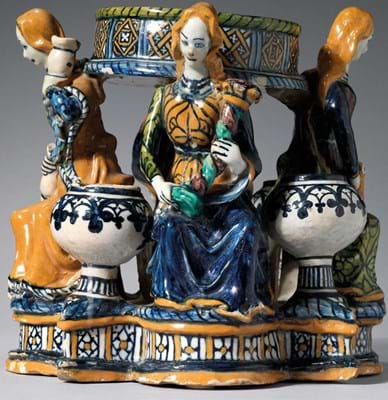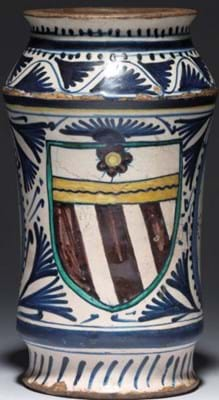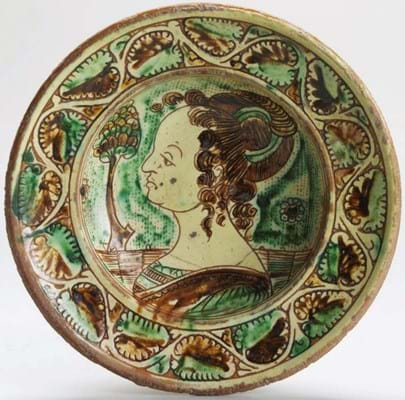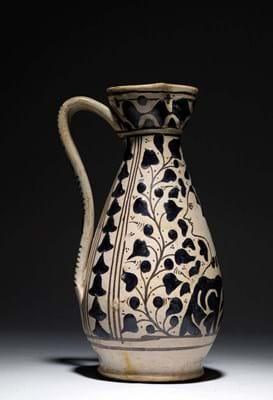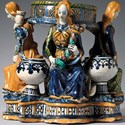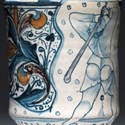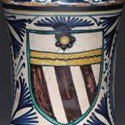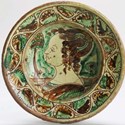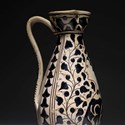Early maiolica, those Italian pottery creations of the late 13th to early 16th centuries, could be due a revisit.
It is the istoriato pieces of the later 1500s, works of riotous colour which feature complex seascapes or mythological scenes, that tend to occupy the minds of collectors and enthusiasts. However, an exhibition at medieval specialist Sam Fogg seeks to redress the balance, focusing on the earliest examples of this technique and tracking its Quattrocento development.
Running from May 8-June 16, the Mayfair gallery’s exhibition Maiolica before Raphael showcases around 50 works made between c.1275 and 1500. The timeline of the show includes examples of the pottery that will be more familiar, featuring the brilliant white surfaces and polychrome decoration over the top that typifies the style.
But these are features that come later in maiolica’s development. This show actually starts with some of the earliest examples of archaic ware, created pre-1300, which are decorated with a limited palette of green and brown locally sourced pigments.
It then tracks the technique’s development, displaying some of the first pieces to incorporate a cobalt blue imported from Persia at the end of the 14th century, as well as the introduction of the intense white achieved only after the arrival of tin brought from Cornwall.
The gallery’s Western specialist Matthew Reeves describes these early works as the result of a “synthesis of influences”. High-value imported pigments and materials are used to create designs that often incorporate a range of decorative motifs – from local metalware design to the lustreware patterns of Islamic Spain.
Recently, he adds, maiolica exhibitions have incorporated such pieces only as “the beginning of istoriato, which is what people are crazy about. It gets all the high prices at auction and it’s been the most celebrated form of this pottery.
But if you look at the early days of the technique without presenting it as the dark ages of maiolica, it’s fascinating in its own right.”
Unlike their highly decorative successors, these pieces are frequently functional. The show that owner Fogg and his team have
assembled includes an inkstand and a wine jug as well as several pharmacy and drug jars. However, these were luxury items nonetheless, vastly expensive to produce and consuming huge amounts of timber during two or three firings.
The result is that even those pieces that came out imperfect were not discarded. On some an overheated kiln has caused the glaze to run; on others faint guide lines have been traced, showing how designs were changed between the planning and execution stages – engaging moments that create a sense of immediacy between the craftsman and the viewer.
Pieces are priced between £10,000 and £100,000 – still lower at the top end than the prices istoriato can command at auction (last year a 16th century charger by Enea Vico took £210,000 at Sotheby’s London).
Five years’ preparation
The assemblage is the result of five years of research and collecting by the gallery.
Forty-three of the works are presented in a catalogue prefaced with essays by Elisa Sani and Justin Raccanello on the development of the maiolica and the history of its collection, which started in the 1870s with artists such as William Holman Hunt and Charles Fairfax Murray. It is, the gallery suggests, the first exhibition of its kind in 100 years.
Perhaps the last survey show of early maiolica was the work of Roman potter dealer Alessandro Imbert, who staged his 1912 exhibition at the Musée des Arts Decoratifs in Paris.
“Unfortunately,” Reeves adds, “he put a huge amount of fakes in the show.”
Sam Fogg has worked to avoid earlier missteps, collaborating with experts such as the Ashmolean’s Timothy Wilson as well as Sani and Raccanello to verify its collection.
The academic influence that has inspired the compilation of the show is set to continue during its run. On May 5, the gallery hosts a one-day conference that will focus on Italian ceramics of the early Renaissance.
The event is likely to be popular and is already getting booked up. There is more of a question mark over the show as a commercial enterprise though.
However, he adds that there has already been some attention from both private collectors and museums.
“Most museums worth their salt will have maybe two examples of early maiolica,” he says. To see 50 such examples on offer at a London gallery could therefore be a once – or first – in a lifetime experience for collectors and enthusiasts alike.


